Baltimore Business Journal, September 5, 2013
Broadband Internet, at its core, comes down to a pipe buried three feet underground and snaked with fiber-optic cable. It has also emerged as one of the most hotly debated issues of the information age, subject to a tangle of federal regulations and millions of dollars in telecommunications industry lobbying.
That pipe in the ground, running alongside utilities such as electric, water and cable television, is increasingly pushing cities like Baltimore to view broadband Internet as essential infrastructure with the potential to transform the business landscape and improve quality of life for residents. That’s why city Chief Information Officer Chris Tonjes’ decision to explore how to expand broadband Internet access in Baltimore is drawing so much attention in the tech and telecommunications communities.
Untapped potential
To those familiar with municipal broadband efforts, the potential is huge.
Adding capacity to a publicly owned fiber-optic network offers opportunities for private operators to lease out the fiber to connect businesses and institutions. And the leasing can provide revenue to the city to continue building out the network, eventually providing enough infrastructure that could attract more Internet service provider options for residents and businesses, many of whom say they’re stymied — and getting angrier — about their current Internet speeds.
…snip…
Residents also are frustrated with the lack of options.
When Roland Park resident Phil Spevak called a community meeting to discuss lack of Internet options this spring, “we had people show up from all over the city.” Later, when Spevak sent out a survey to gauge interest in broadband options as part of his role in coordinating the Roland Park master plan, between 300 and 400 people responded and “they were all upset and wanted better performance.”
Now Spevak is leading a campaign to get 20 percent of residents in Roland Park, Roland Springs, Wyndhurst, Mount Washington and Homeland to commit to subscribing to broadband Internet service from a private company. If the communities can get that commitment, they want to head to the market to look for new providers.
“We think if we can demonstrate 20 percent backing for that sort of performance, we’ll go to our next step to release an RFP to provide services in this part of Baltimore,” Spevak said. “This affects us from a business point of view, a growth point of view. I don’t think the city is positioned appropriately.”
Community-based efforts are becoming more common due to the frustrations with a lack of options, said Christopher Mitchell, who leads the Community Broadband Networks initiative at the Institute for Local Self-Reliance in Minneapolis.
“If you live in a city where only Comcast is offering services, you don’t have any control over prices they charge,” Mitchell said. “Small companies can’t compete because Comcast will run them out of business if they invest in infrastructure by suddenly lowering prices and offering faster speeds.”
Mitchell said that Baltimore’s planning signals a move away from relying on large telecom providers that is a modest start, but one that could attract competitors in the future.
“What Baltimore wants to do is alter the equation by making it less expensive for either a private competitor to compete or build enough assets to compete on its own,” Mitchell said. “What they need to do is figure out how they can get more fiber into more places to lease to potential companies.”
Comcast vs. competition
Tonjes, the city’s chief of information technology, has said he is not pursuing expanding broadband infrastructure in the city to “demonize Comcast.” In fact, Comcast could be the company that ultimately leases the fiber the city builds, Tonjes said.
But so far, Mitchell said that doesn’t fit Comcast’s model. In other cities, officials have used revenue to build out the broadband network until a private operator decides there is enough infrastructure already available to extend service from a major corridor to residents’ and businesses’ doorsteps.
Most infrastructure that supports high-speed Internet has been built downtown by private companies such as Zayo, but the services are generally only provided to businesses. Small and medium-sized businesses not willing to pay for new infrastructure are often left with few options, such as Comcast.
“The city, by having these fiber-optic cables, is providing something that is not available and is attractive to a certain kind of telecommunications company that wants to run its own network,” Mitchell said. “In a place like Baltimore, [Magellan Advisors] is not going to recommend the city do anything particularly risky. But if Baltimore can make some investments and make it easier to serve small businesses, these small businesses will have more choices and more reliable service.”
Comcast could not be reached for comment.
Still, both Mitchell and Buske said the city is likely to face opposition and lobbying from big telecom providers such as Comcast and Verizon.
Mitchell pointed out that the day after the Board of Estimates voted to hire Magellan Advisors, the Baltimore Sun published an op-ed piece by state Sen. Catherine Pugh that warned municipal broadband had proved a boondoggle for taxpayers in other areas.
The language in the op-ed echoed anti-municipal broadband talking points advanced by large telecom providers, Mitchell said, and while “we’ve had a few cities that have done dumb things,” he said most broadband efforts had been at least modestly successful.
…snip…




